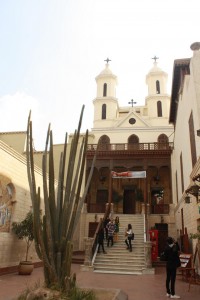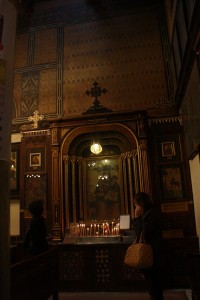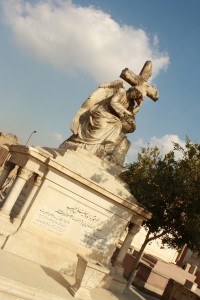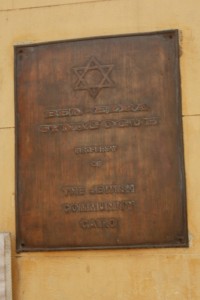
Rana Muhammad Taha
Exiting the Metro at Mar Girgis, you are about to step into a time long passed. It does not take much time to climb up the steps and once outside the station you are on a level with the tall steeples of the Hanging Church. Welcome to Coptic Cairo.
Embedded in the heart of old Cairo, the timeless tourist attraction of Coptic Cairo is easily accessible via Metro. The Mar Girgis station lies on the Marg/Helwan line and leads directly to the historical Mar Girgis Street. Otherwise, a car ride is always possible, though you may have a hard time parking.
Regardless of the means of transport, once there you are met with the seemingly endless track of places of worship huddled against one another, bringing a feeling of peace and serenity. Perhaps it’s that comforting feeling which drew the holy family here some two thousand years ago to use this place as a hideout, or so the legend claims.
Almost some 600 years later, Egypt’s Muslim ruler Amr Ibn Al-’As chose a nearby spot to build the first Mosque in Egypt and the whole of Africa. With the Ben Ezra Synagogue subtly nestled in the complex of churches, this special neighbourhood serves as a perfect display of the three heavenly religions embraced in Egypt.
The Hanging Church
During their journey in Egypt, Mary, Jesus and Joseph are believed to have taken refuge in what would later become the Fortress of Babylon. This is one story explaining why Egypt’s oldest remaining church was suspended upon the gates of the Fortress of Babylon in the third of fourth century. Another suggests the place was used as a sanctuary by nuns and so the church was built there.
The church doesn’t reveal itself to outsiders; it is fenced by huge protective walls with words etched in Coptic and Arabic. Through the gate, a small porch leads to a courtyard from which the twin steeples of the hanging church are finally visible. The walls screening the courtyard are decorated with mosaic drawings depicting the holy family’s tortuous escape from Palestine. A Coptic music store is on the right; beautiful hymns usually emanate from the small store.
To reach the church, you first must climb 29 steps that draw attention to the church’s suspended architecture. The Hanging Church served as the residence of the Coptic Orthodox Pope for centuries and a small corridor inside includes pictures of several Patriarchs. The entrance corridor also includes pictures of Coptic Popes with Egypt’s rulers over the last hundred years or so. The latest addition is a photograph of Pope Tawadros II with President Mohamed Morsy.
A roof-less ante-chamber hosts a small souvenir display, a map of the holy family’s trip to Egypt and a miniature cave depicting Mary with Jesus in his cradle and a herd of sheep nearby.
The inside of the church is dominated by an impressive wooden ceiling made to resemble Noah’s ark. A total of110 golden icons of holy saints cover every corner. Perhaps the most outstanding is an icon of Virgin Mary holding baby Jesus in her arms. The huge icon is within a triple-layered frame of embossed pillars and lit by a brilliant stenciled copper lamp.
“Let’s light a candle for Lydia, shall we?” a Coptic mother calmly suggests to her excited children, who, in turn, each pick up a candle, light it and place it next to the other blazing candles in front of the Virgin Mary icon.
“Whenever we want something from God, we come here to make a wish, light a candle and pray for this wish to come true,” the mother explains with pride.
Apart from the icons, the church also hosts relics of a number of martyred saints; most notably that of St George, after whom the whole street making up Coptic Cairo is named. Other relics include those of St Claudius and St Dimiana. All relics are boxed in wooden compartments.
At the far right of the altar, a door leads to a special praying area with a secluded, wooden window. The window provides the sole remaining view of the hanging church’s perch. Outside the window, the ruins of the Fortress of Babylon, upon which the church rests, are clearly visible.
The Coptic Museum
Inaugurated in 1910, the Coptic Museum lies just north of the Hanging Church and the fortress ruins and carries a wide collection of Coptic monuments. Founded by Marcus Pasha Simaika, a railway administration employee, the museum aims to lay out the Coptic history in a manner weaving the Pharaonic, Greco-Roman and Islamic antiquities together.
From the Greco-Roman era, fourth and fifth century sculptures depict various Greek gods and rulers. The museum includes monuments from the Monastery of St Jeremiah and the Monastery of St Apollo. It also hosts a number of exhibits provided by the Coptic community since the museum’s foundation. The artifacts include icons, manuscripts, metals, textiles, wood carvings and pottery.
Open from 9 am until 5 pm, the museum charges Egyptians a little less than foreigners. While a ticket for locals costs a modest EGP 2, foreigner must pay EGP 40. Students, both Egyptians and foreigners, get a 50% discount off their ticket prices.
One notable downside is the prohibition of any form of photography inside the museum, unless you have a written permission from the Supreme Council of Antiquities. One is asked to leave cameras with the museum administration before admission.

Rana Muhammad Taha
The Greek Orthodox Church of St George
Down the street from the Coptic Museum, follow a huge brick-wall to a wooden double-door. Pass through and enter the magnificent monastery of one of Christianity’s most famous martyrs, St George (Mar Girgis). Born to a devoutly religious father, St George embraced the Christian faith despite the hardships of the era in which he grew up.
A brave soldier, St George stood up to the tyranny of Emperor Diocletian and refused to succumb to pressure to renounce his faith. He was subsequently tortured for seven years by Diocletian. During his torture, it is said Jesus Christ appeared to St George repeatedly and treated his wounds. He was eventually beheaded in 303 AD.
The Greek Orthodox Church is on the right of the gate. Confusingly, a inscription in Arabic and Coptic suggests the church is Roman Orthodox but pay no heed. Beginning with an ultra-wide set of white, marble stairs, the church is built in a huge, circular shape to resemble the Fortress of Babylon. It is most recognisable for its large dome and steeple. Though the church is currently being renovated, visitors are allowed access to parts of it.
The ground floor of the church includes the bazaar room, where the instruments of torture used on St George are put on display. The sharp, pin-studded shoes, the cross and the wheel of swords upon which St George was lacerated are kept within a niche in the bazaar. The chains used to hold the martyr are also kept.
Supposedly used for hanging St George, the chains are believed to endow those who wrap them around their necks with exceptional grace. Egyptians, both Copts and Muslims, bring their children to the Church especially to gain the favour of the chains.
A group of four teenage Copts stood by the chains, excitedly taking turns and being photographed. The group then moved to an adjacent room, where they bent to walk through a tiny entrance, passed a metal door on the left. Inside, a very dark, cave-like room hand drawn crosses and scriptures from the bible decorate the walls.
“This is the prison where St George was held,” one of the boys says, moving deep into the room. He bends down in front of the wall, facing a tiny, wooden window. “This is where he used to pray,” he says, holding his hands together and imitating St George in prayer.
The chapel of the church stands apart from any other chapel in the area. Designed to resemble European churches with their extravagant majesty, the chapel is high-ceilinged and offers a kind of beauty seldom found in Egypt.
At the left side of the gate, a huge ancient cemetery can be found. Though the white, marble graves seem to resemble one another at the start, once one begins to delve deeper, the older, finely sculptured graves begin to surface. Some of the graves are built in the shape of a tiny house; all with a double door and sloping roof. The place also hosts a Greek Melkite cemetery and a Coptic Orthodox Cemetery.
At the heart of the cemetery lies yet another scene. This one shows the holy lands in which Mary, Jesus and Joseph took shelter during their trip to Egypt. A room includes the well where the holy family used to drink. Still in use, the water is believed to be sacred and is drunk for blessings. A small cave-like room lies at one side of the well. Inside lies the grindstone the holy family used to grind their food. The other side of the well contains yet another tiny room, believed to be the place where Mary would pray.
Ben Ezra Synagogue

Rana Muhammad Taha
Underneath the Greek Orthodox Church, a narrow, twisting passageway leads you to what is known as Harit Al-Kidees Girgis, or the alley of St George, reached via a steep flight of stairs on the main street. Down there, in the Old Cairo Bazaar, various vendors put their varied souvenirs on display. The products can be as simple as beaded bracelets and accessories, expanding to include silverware, framed drawings and pictures, papyrus and books in several languages.
On the left lies a huge wooden door, usually closed and leading to the Nunnery of St George. The convent hosts the shrine of St George. It also hosts another chain used in the torture of the holy saint.
Deep into the alley, as it twists to the right, you are met with a couple of passageways. The one on the left leads you to St Barbara Church. The church was originally built to honour St Cyrus and St John for their healing powers. It is also believed to have once hosted the relics of St Barbara, according to a document reclaimed from the 13th century.
The right passageway leads to the Ben Ezra Synagogue. Why would a Jewish synagogue be hidden between this collection of Christian churches, in a place known as Coptic Cairo? The answer is quite simple; because the Ben Ezra Synagogue was originally a church.
Short of money, the Coptic Christian community had to sell the church in 882 AD in order to pay the annual tax imposed on them by the Muslim rulers.
The Palestinian Abraham Ben Ezra then bought the church for 20,000 Dinars, turning it into a Jewish Synagogue. Nevertheless, legend has it that the place upon which Ben Ezra was built is where Moses was found as baby in the Nile thousands of years ago. The place was given to the Jewish community by Alexander the Great to build a house of worship in 300 BC.
The building still maintains the basilican structure, with the numerous pillars and confessionals still standing. It also encompasses some Islamic symbols and Turkish patterns. Two stories high, the ground floor is for men and the top floor is for women. The middle of the synagogue holds the bima (Torah-reading platform); of octagonal-shape and white-marble. Be careful though, for despite the beauty of the place, pictures are not allowed inside.
The synagogue is famous for enclosing the Cairo Geniza; a hiding place where old Torah scrolls and manuscripts were disposed of. While being renovated in 1892, the Geniza, which dates back to the Middle Ages, was discovered. It was that discovery that makes the Ben Ezra Synagogue a sacred Jewish monument to this day. It was also the destination of North African Jews performing pilgrimage centuries ago.
Unlike the other places of worship in Coptic Cairo, entrance to the synagogue is preluded by a serious security check. Once past the check, you are met with a welcoming sign; a Star of David describing the Ben Ezra Synagogue as the “property of the Jewish Community in Cairo”. But sadly, the synagogue is almost deserted when it comes to worshippers. It’s only used for prayer during major Jewish celebrations. At least ten Jewish men need to be present in order for prayer to be held , according to Jewish ritual.

Rana Muhammad Taha
Amr Ibn Al-’As Mosque
After the Greek Orthodox Church of St George and the Old Cairo Bazaar, Mar Girgis Street and the whole of Coptic Cairo is basically finished, save for the few antique, copperware and silverware shops standing opposite to the holy sites. Metal gates barricaded by police separate the Coptic Cairo district from the outside world. Get past the gates and you’re in the ancient city of Fustat; a city founded by Muslims upon their arrival in Egypt.
A few metres apart from Al-Fustat shops stands Africa’s oldest Mosque. Amr Ibn Al-’As mosque was named after its founder, Prophet Muhammad’s companion and Egypt’s first Muslim ruler.
The Mosque is a perfect depiction of early Islamic architecture. It was built in the style of the Mecca and Medina mosques; with a courtyard in the middle and a large dome at its centre. The dome covers a huge water sink; for drinking only; no ablutions allowed, the sign says.
Jam-packed with white-marble pillars, the mosque has a small bookshelf every couple of metres. Sheikhs usually gather their scholars around one shelf when giving Islamic lessons or engaging them in discussion. Mosques are no longer built in that style in Egypt; a fact which gives Amr Ibn Al-’As Mosque extra rarity.
Expanded repeatedly over the years, the mosque is now huge. Legend has it that if full to the brim with worshippers, it would fly away.
Entering requires removing off your shoes, as is the case with any mosque. For women, a large, green hooded robe is offered to cover their hair and provide suitable attire.
Outside the mosque, you can always visit the Fustat shops for souvenirs, or step into the Tivoli restaurant and cafe to relax.
A trip to Coptic Cairo takes a day to visit all the different sites, yet leaves an unimaginable impact; visiting is a must if you’re sightseeing in Cairo. If not for the brilliant monuments and houses of worship representing different eras; the place is special for the image of a harmonised Egyptian community comprising of different faiths. Once there, you can almost forget about any hate-speeches or religious strife elsewhere.




